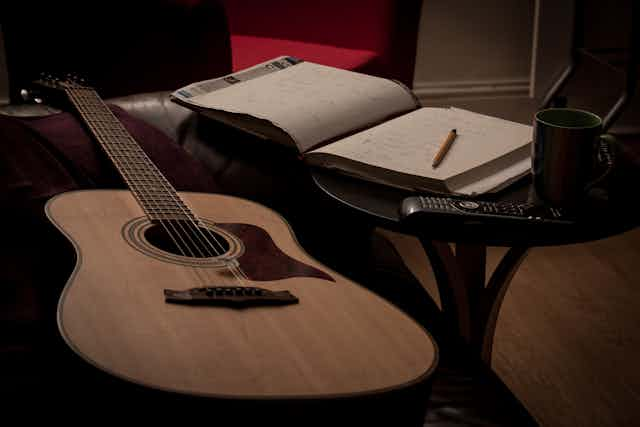“Music is healing, music is medicine. In times of trouble, music is what we turn to,” said Deltra Goodrem on last week’s episode of The Voice. Two contestants that night told how music had helped them cope with their personal struggles. A young man had lost a mother at an early age; while a woman described living with facial palsy after having surgery to remove a brain tumour.
The panel members also shared their own perspectives. Ronan Keating spoke of how music helped him after the early death of his mother. Jessie J, who had a stroke when she was 17, told how songwriting helped her through tough times.
I am somebody who needed music, I needed to write [songs] to survive. I needed it to understand how I felt, it was an emotional outlet for me […] it has definitely helped me through some of the toughest moments in my life.

Songwriting is a creative and worthwhile therapeutic tool, even for people who don’t call themselves musicians. I’m studying, in a three year project supported by an Australian Research Council Discovery Grant, the effect of songwriting on people undergoing rehabilitation after acquiring a brain or spinal cord injury.
Many are young adults in the prime of their life. The 38 people registered in the study range from 18 to 60; most were involved in motor vehicle accidents. Others were injured by unexpected events such as strokes or brain tumours.
Over 12 sessions a trained music therapist guides them as they each write three songs expressing their emotions at different stages of the process. The chorus typically expresses the central feeling or issue. For example, this is a chorus written by a person who received a brain injury after a drug overdose:
Looking at myself through strangers eyes,
The person looking back at me I barely recognise,
A fog has descended over my mind,
Personality gone words hard to find.
The therapist helps everyone experiment with genres until they find the style of music that expresses their feelings and story. Some songs are sung with guitar or keyboard, while others use GarageBand software on an iPad to create a full accompaniment with drums, bass, guitar, keyboard and other instruments. Letting people have full control over the music is key to ensuring they feel full ownership of the song.
Grieving for the past
The first song aims to explore participants’ identities before they became injured. The therapist encourages people to explore their pre-injury story, and lyrics often include references to family:
My family, are such a part of me.
They are the meaning in my life,
They give me strength to keep on going.
Creating this song is a chance to reminisce and grieve about the life that’s no longer theirs.
Accepting the present
After the lyrics and music for the first song are recorded, the second song is created, this time exploring the present. It is a song about who they are at this moment, as a person with an acquired disability. This is often met with a mix of emotions; people oscillate between wanting to hold on to the past identity but also recognising and grieving what is lost and acknowledging the need to move ahead with their lives.
Song lyrics may focus on the physical self, as in these three examples:
When I look in the mirror, it doesn’t look like me,
Subtraction of my hair and addition of a chair.I live in the same body but it can’t talk to me anymore.
Feeling pretty useless, can’t even wipe my own arse, no options for work now,
Things will be different from the past.
Looking forward

During the creation of the third song, there is a focus on looking towards the future. This is a chance to try to integrate the pre-injured identity with the post-injury self.
For some, the songwriting experience helps them express their painful experiences and project their emotional responses to these into the music. All genres of modern music are represented in the repertoire of songs created so far. Slow and mellow ballads communicate longing for a life lost, while the rawness of distorted guitar riffs express anger towards themselves for the poor life choices that led to their injuries.
The music functions to fully express pain and loss, but also to celebrate the “second chance at life” that many express in their lyrics.
For example, one man who had received an acquired brain injury following a motor vehicle accident sang:
This accident has brought me to my knees,
Forced me to confront, my mortality,
Made me question my beliefs, maybe I had it wrong, and
Opened my mind to the possibilities
We have now moved onto testing the approach in a large scale randomised control trial also funded by the Australia Research Council.
But our pilot study, published in Frontiers in Human Neuroscience found that our intervention had a strong positive impact on people’s sense of self, levels of depression and anxiety.
Songwriting enhanced their satisfaction with life and strengthened their sense of flourishing; and it helped people cope with painful and confronting questions about their identity.

